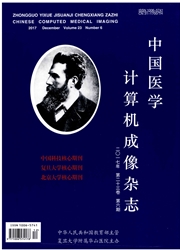

 中文摘要:
中文摘要:
目的:评估肺结节热消融治疗后胸膜损伤的CT表现,探讨其与术后并发症的关系。方法:对我院2013年7月-2016年7月40例患者的57个肺结节进行CT引导下热消融治疗,回顾性分析术后消融区域的CT改变和并发症发生率。结果:40例患者均完成热消融治疗,当消融区域邻近胸膜时,脏层胸膜出现局部凹陷,本组研究中8例患者出现该征象,其中6例(75%)术后发生胸膜相关并发症,4例(50%)行胸腔闭式引流。结论:肺结节热消融术后局部脏层胸膜凹陷可能是胸膜损伤的表现,提示患者有较高的胸膜相关并发症风险。
 英文摘要:
英文摘要:
Purpose: To evaluate the CT manifestation of pleural injury after thermal ablation for pulmonary nodule, and to analyze its relationship with post-ablation complications. Methods: A retrospective analysis of our database was performed between July 2013 and July 2016, and a total of 40 patients (57 pulmonary nodules) underwent CT guided thermal ablation. Post-ablation CT findings and complications were analyzed. Results: Thermal ablation was successfully accomplished in all patients. Visceral pleural indentation could be observed on CT scan when the ablation zone was adjacent to pleura. This sign was found in 8 patients, 6 of which (75%) had pleural- related complications. Among them, 4 patients (50%) underwent thoracic closed drainage. Conclusion: Visceral pleural indentation might be the sign of pleural injury after thermal ablation for pulmonary nodule, and it might suggest high risk of pleural-related complications.
 同期刊论文项目
同期刊论文项目
 同项目期刊论文
同项目期刊论文
 期刊信息
期刊信息
